


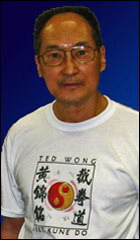
Ted Wong is one of the most knowledgeable person in the world when
it comes to Bruce Lee's (TM) art of Jeet Kune Do (TM).
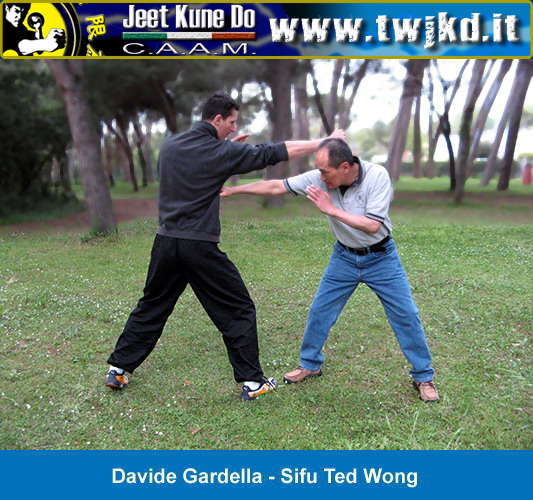
Ted Wong had trained personally by Bruce Lee(TM) in the art of Jeet Kune
Do (TM) from 1967 to 1973, and became Lee's last private and workout
partner. Wong received certification in Bruce Lee's Jeet Kune Do (TM) from
the founder himself, and in his youth appeared alongside his mentor in the
classic "Bruce Lee's (TM) Fighting Method" book series.

Wong continued to pass on Bruce Lee's (TM) martial teachings to a highly
selected group of private students and through seminars around the world.
Ted Wong also serves as one of the Board Members of the Bruce Lee (TM)
Foundation.
Training with the Dragon:
Few individuals were as close to Bruce Lee (TM) as Ted Wong. Now 57
(in 1994), and still teaching the system he learned from Lee, Wong can
offer important insights into the late Dragon's training and instructiona
l methods. As a friend and training partner of Lee, Wong gleaned
technical and philosophical information from the legendary martial
artist that most individuals were never privy to. In the following Dragon
Spirit column, Wong explains what changes he thinks Lee would have
undergone in his personal training, and in his overall outlook on the
martial arts, had he been alive today-- Editor
After Bruce Lee (TM) died, I remained quiet for a number of years. But
in the past few years, I have started to get a little more actively
involved in the martial arts and Jeet Kune Do (TM). I had always wanted
to teach the martial arts someday, but during those years, I felt I was
still learning and still training. But I think after 20some years, I have
paid my dues and put my time into it. I have found that people really
want to learn the original art and what Bruce Lee (TM) taught when
he was alive. That's the reason I'm teaching now.
I teach, as closeas I can, the art that Bruce taught, and hopefully
it has evolved andchanged, and become better. I basically teach
the fundamentals ofJeet Kune Do (TM), based on Bruce's philosophy
and principles.
Over the years, I have tried to improve on it and make it better.
Probably only one percent of those teaching Jeet Kune Do (TM)
today are still teaching Bruce's art. Keep in mind that he did not
really teach or talk about Jeet Kune Do (TM) to many people in his life.
I can't find one instructor who teaches the original form fulltime;
it's more like a hobby. I think Bruce would be pretty pleased with
the martial arts today. A lot of people apply his philosophies and
principles, but with his concepts, you can make them conform to
other martial arts and, in so doing, they will improve them. The
martial arts have really come a long way since his passing.
They have become much better and more practical. Bruce always
wantedto stay away from the martial arts being used as a sport.
I thinkhe tended to stay away from it as a sport because you could
notfully utilize the art or its potential. It was not the ultimate martial
art unless it was "anything goes." Bruce wanted to practice an art
that he could use. No holds barred, no holding back, anything goes
- that was his philosophy. But I think today Bruce would also like
the sport portion of martial arts because you develop speed, power
and timing- things you can apply to sharpen your skills.
As far as noholdsbarred tournaments like the Ultimate Fighting
Championship (UFC), I don't think Bruce would enter something
like that. The UFC still has some limitations to it, even though they
refer to it as ultimate fighting. There are still rules that say you
can't do this or that. But I think as a test of your skills, Bruce would
like it. I don't think Bruce really liked teaching. He definitely didn't
like to teach large groups. If anything, he enjoyed teaching one
on one, or small groups. He always found a new way to develop
different muscles, to improve speed or whatever. I'm sure he
would still be looking for ways to improve conditioning, especially
ways that no one else had discovered. He was always researching
, reading and looking for more knowledge, analyzing it, and trying
to utilize it. The way Bruce taught and trained was always
individualized. He would gear the training to work for you.
Bruce could look at you and see what you were lacking and what
your potential was. and then he could fully develop your potential
. I think he was always looking at the individual and developing a
program to suit that individual. Bruce was a great motivator. He
would get interested in you and consumed with the idea of doing
everything to motivate you. If he were still alive today, he would
still train and be looking for ways to improve. Because he once
said that if you are lacking in your physical ability and conditioning
, then you have no business in the martial arts.
Ted Wong conducts
"sticking hands" practice with Bruce Lee (TM) during one of their
many training sessions. He spent most of his time developing,
researching and experimenting with his art. That left him little
time for teaching. In those days, seminars were unheard of.
It wasn't until the early 1980s that people started teaching
seminars to large numbers.
When I train now, I always think about him. I try to apply the things
I learned from Bruce and use them in my daily routine. It makes me
a much better person. People always ask me about his physical
conditioning. I looked up to him because he set the standard to
follow in training and conditioning the human body. If he were
here today, I believe he would be in even better shape. I don't
think he would ever let himself go.
Articles courtesy of Black Belt Magazine
Interview with Ted Wong
Article published in "Knowing is Not Enough", fall 1997 - Page 1
Ted Wong probably spent more time with Bruce Lee (TM) during the development of his art of Jeet Kune Do (TM) than any other individual presently living. More importantly, the two men became great friends and more often than not what little spare time they had was spent in each other's company. Ted received certification in Jeet Kune Do (TM) directly from Bruce Lee (TM) himself and was Bruce Lee's (TM) last private student. In looking at Bruce Lee's (TM) daytime diary for the year 1967, one sees that Ted Wong was first invited to Bruce's home on April 20th of that year. This would prove to be, in the words of Humphrey Bogart, "the beginning of a beautiful friendship," that would endure up until Bruce Lee (TM) passed away on July 20, 1973.
For years Ted Wong has taught privately, usually to only a handful of dedicated individuals who would make the trip to his home in Monterey Park, California to train in Ted's backyard. He is a humble man, a dedicated man, and a man fiercely loyal to Bruce Lee (TM), in terms of both the art he taught and the message he communicated.
Close friends: Bruce Lee (TM) (left) and Ted Wong (right) became fast friends shortly after their first meeeting in 1967. Here they take "five" from a backyard workout at Bruce's house long enough to pose for a quick snap shot.
Linda Lee Cadwell recollects that Ted's teaching is perhaps the purest strain of her late husband's art and is quick to seek Ted's counsel on matters pertaining to the technical aspects of Jun Fan Jeet Kune Do (TM).
Ted Wong is also, as were all of Bruce 's closest friends, the most decent of human beings. Time and again he has foregone payment at seminars, and even gone into his own pocket in an effort to help spread the teachings of his sifu, Bruce Lee (TM). In this day and age, such altruism is considered shocking. When Ted Wong speaks, he speaks with the air of unimpeachable authority, and we at "Knowing Is Not Enough "are very pleased to be able to present this in-depth interview with Ted Wong to our readers and members ol Jun Fan Jeet Kune Do (TM).
-- John Little
For the benefit of some of our members who may not know, how did you first meet Bruce Lee (TM)?
TED WONG: I first met him the day that he opened up his Chinatown School. I'd actually been around him some six months prior to that, but Ididn't have an opportunity to introduce myself to him.
Where was this?
TED WONG: He was training with a couple of his students in Chinatown. At that time it was just a big room in a theater that was used as a recreation room by the Chinese community in Los Angeles. People would go there to play chess and ping pong, and Bruce Lee (TM) used that same place to go and train. A friend of mine had told me about it and that was actually how I first heard about Bruce Lee (TM). So I went there on a couple of occasions but just sort of stayed in the background and watched him. I was a little too intimidated to just walk up and introduce myself. And then a few months later, February of 1967 to be exact, it was on a Saturday morning, my same friend told me that Bruce Lee (TM) was opening a school. And that was the first time that I formally met him.
What was Bruce Lee (TM) doing during that "opening day" ofthe Chinatown school?
TED WONG: He was giving a lecture and talking about his art. It was really quite an eye-opener for me listening to him talk about his Gung Fu. It wasn't Jeet Kune Do (TM) when the Chinatown school first opened, he hadn't yet coined the term [Editor's note: According to Bruce Lee's (TM) daytime diaries, the Chinatown school opened "officially" as the"Jun Fan Gung Fu Institute" on Thursday, February 9, 1967 one month before the official cancellation of The Green Hornet TV series. It was on Sunday, July 9,1967, some five months later, that the art of "Jeet Kune Do (TM)" was conceived]. I was fortunate enough to be there and to sign up for his class, and the rest is history.
Article by Ted Wong and Tommy Gong
Jun Fan Jeet Kune Do's (TM)
Later Developments:
From the Bruce Lee (TM) Jun Fan Jeet Kune Do
(TM) Magazine, December 1997.
The later developments of Bruce Lee's (TM) Jeet Kune Do (TM), prior to his untimely death, are some of the least understood. Most people separate Lee's stages of development by the places where he resided, acknowledging that he initially practiced Wing Chun Gung Fu and modified it into Jun Fan Gung Fu in Seattle, further developed Jun Fan in Oakland, and later created Jeet Kune Do (TM) in Los Angeles. Others notice changes in Lee's development by understanding what martial arts influenced him such as Wing Chun, Boxing, and Fencing. We must understand, however, that these stages are not this clearly delineated. Specific developments in JFJKD gradually occurred over time, and distinct phases overlap each other considerably. In addition, mere technique cannot explain these stages; one must also study Bruce Lee's (TM) mental approach in fighting and philosophy of life to better understand Jun Fan Jeet Kune Do (TM).
Bruce Lee's (TM) Evolution:
One may assume that Lee taught each student differently, giving something quite unique to each disciple, since each individual he taught had varying needs. But it is not this clear cut. Upon analyzing Bruce Lee's (TM) private notes, one discovers that Lee essentially taught the same things to all his students with the exception of some slight modifications to fit the individual student or to emphasize certain points or ideas that the student needed help with. From Joe Lewis to Kareem Abdul-Jabbar to Stirling Silliphant to all the members of the Nucleus who trained under him, Lee taught essentially the same techniques during the same time period (1967-70). What Lee probably discovered was that certain students excelled at executing certain techniques while other students performed other things better, and the idea was how to optimize their strengths and cover or protect their weaknesses. We must understand Lee concluded that since we only have two hands and two feet, the objective was how to use them to the maximum. However, one must also consider that Lee's students most likely received what he was emphasizing in combat at the time. As Lee was developing as a martial artist, he was discovering more truths in combat for himself, so what he found to be important when he resided in Seattle would not necessarily be important to him when he lived in Los Angeles. To qualify this, there were certain principles that Lee maintained throughout his lifetime. Moreover, what was taught in a class setting sometimes varied from what Lee practiced at his home with a few students. At the school, a class curriculum was followed to develop a student into a well-rounded fighter. But when training privately with Lee, the student learned what Bruce Lee (TM) was personally working on at the time. Does this mean that the Chinatown School students practiced radically different things than that of Lee¡¦s private students at home? No, but the level of expectation and refinement were probably higher (that is, when working with Bruce) and more experimentation was performed.
Moreover, students in the same class will often pick up on different key points, principles, and/or thoughts. Often students will concentrate harder on things they perform better or understand more deeply. For instance, Dan Lee excels with explaining the Yin and Yang aspects of Jeet Kune Do (TM) while Ted Wong emphasizes the importance of footwork. Furthermore, who better than his own students who knew Lee and were familiar with his circumstances to explain his art of JFJKD. This is why it is important for Lee's students to contribute what they learned from their great teacher, Bruce Lee (TM). It is this collection of information that needs to be preserved for future generations. To summarize, although Bruce Lee (TM) had quite a few students in his lifetime, they had all learned something different from him based on their individual needs, what Bruce Lee (TM) was concentrating on at the time, and what each student perceived to be important. Most of Bruce Lee's (TM) changes and developments were not taught to his students, but one could observe him during training sessions and sense changes in his movements. A slightly different angle of delivery here, a little more penetration in the sidekick there, a small difference in the timing of the punch, etc. In addition, a lot could be learned from Lee by sparring with him. His tactics, strategies, and movements improved over time toward more combat effectiveness and efficiency. As a result, it became increasingly difficult to spar him. Even the videos of Bruce Lee (TM) sparring during the 1964 and 1967 Long Beach Internationals Tournament were not representative of how he would spar just a few years later (1969-71). Furthermore, the improvements were actually slight, subtle changes that accumulated over time. It is the sum of these changes that makes it more apparent. If someone could observe Bruce Lee (TM) throughout this transformation, he would notice a gradually changing system; but if only observing Lee's beginning and end products in the martial arts, he or she would note two different fighting systems. For instance, without any prior knowledge in JFJKD, one would think that Lee¡¦s students in Seattle were taught by a different teacher or even studied a different martial art from his students in Los Angeles.
Bruce Lee's (TM) Revolution:
The most dramatic difference, however, was Bruce Lee's (TM) approach to fighting and way of critical analysis about fighting. It was not so much his techniques that changed, but rather how Lee analyzed them and as a result, would improve and use them. Sciences such as physics, biomechanics, kinesiology, and psychology were put to use so that a scientific basis was used to optimize the structure of techniques, human performance, as well as validating the effectiveness of JFJKD techniques. For instance, Lee applied such principles as speed, power, broken rhythm, psychological warfare, strategy, and tactics to his fighting so that he could maximize his ability in combat. As early as 1969(?), Lee was scientifically comparing his techniques to those from other arts: an article that year documented the comparison of the Straight Lead Punch from JFJKD to the Rear Punch from Karate with quantifiable results. Lee's liberation from the classical martial arts had already begun in Seattle with modifying Wing Chun to adapt to his different environment. He emphasized adaptability while basically remaining within the framework of the Wing Chun system. This process continued in Oakland, but his altercation with a Gung Fu man forced Bruce Lee (TM) to look more often outside of the system towards more efficiency and a more open view towards combat.
In Los Angeles, since he was developing in directions where Wing Chun would not fit him anymore, he eventually discarded many of its techniques and approaches, forcing him to be outside of the system. Wing Chun was no longer a part of Jun Fan Jeet Kune Do (TM) at this point in Bruce Lee's (TM) life (1969-73). But in defining Bruce Lee's (TM) evolution in the martial arts, Wing Chun is a large and important part of its development. JFJKD could possibly be incomplete without it, as Bruce Lee (TM) stated, "I owe my achievement to my previous training in the Wing Chun style." Nevertheless, in his later stages, Lee discarded Wing Chun as well as all other forms of martial arts because they became less important to him. No boundaries or limitations of any particular system would be imposed on him and he could truly look at combat objectively. Bruce Lee's (TM) development of Jun Fan Jeet Kune Do (TM) was not the mere modification or abandonment of a system, nor to necessarily study or research all different forms of martial arts, but a whole new thought process and approach to the martial arts. The philosophical notion of freedom allowed Lee to be truly free from the restrictions of any art, thereby being empowered to fully actualize his potential as a martial artist. It is with this liberating quality that the JFJKD practitioner really flourishes, and this is why Lee emphasized it so much. He found that being outside of any system allowed him to more quickly improve his martial arts.
Bruce Lee's (TM) Jeet Kune Do (TM):
This leads one to define the JFJKD fighting arsenal and JFJKD philosophy. It is the JFJKD fighting arsenal that actually has its own physical character or flavor, comprising of the techniques and movements that Bruce Lee (TM) actually performed. It is directed at adaptability, combat effectiveness and efficiency, a fighting system stripped down to its essentials comprising of elements from Wing Chun, Boxing, Fencing, etc. But JFJKD philosophy is more universal and can be applied to just about any martial art. For instance, one precept is to merely look at combat or life objectively, not through the lens of one's previous conditioning. This is very significant because most people observe things according to their past experiences. For example, a person with judo experience may associate throwing techniques from another martial art to those in judo. But this limits his scope of objectivity and analysis, because he already has preconceived notions about the mechanics, tactics, and usage of the technique. With JKD, one attempts to look at the art "as is", not what it reminds one of. The JKD practitioner must open up his mind and eventually be free from any particular martial art. Another important notion in JFJKD philosophy is to be like water. In terms of fighting, being like water means to have the adaptability to fit in with any confrontation or combative situation so that you can handle yourself and defeat your opponent. The idea of being soft, yielding, and sensitive also empowers one as a human being to deal with life's problems more effectively by becoming more open-minded with finding creative solutions. In fact, one would be able to apply much of Bruce Lee's (TM) philosophy, which is deeply rooted in Taoism, to live a more positive and rewarding life. However, there is a lot more to JFJKD than simply Bruce Lee's (TM) philosophy, and one may lose sight of Bruce Lee's (TM) total contribution to the martial arts. The JFJKD Nucleus wants to preserve the basic foundations of JFJKD, including its philosophy, so essential for future generations in fully understanding Bruce Lee (TM) and his art. If it is there inclination, students are encouraged to study other martial arts and add their own personal developments once they have the experience and intellectual sophistication to do so. Nevertheless, we simply want JFJKD teachers to concentrate and focus on JFJKD, that is Bruce Lee's (TM) personal expression in the martial arts, when they claim to teach it. In this way, JFJKD can be spread out in a much more consistent way with less confusion.
Lee said that one had to continually evolve to improve and keep pace with this changing world. Lee viewed this as a continual, gradual improvement and advancement of one's martial art instead of fundamentally changing and adding to it. In addition, Lee meant that each individual would have to improve himself for his own personal growth. Lee stands alone as the greatest martial arts of all time. He certainly does not need his students or future generations to "keep him or his art up with the Jones." Furthermore, liberating himself from any particular martial art contributed to Lee's accelerated development. In a sense, Jeet Kune Do (TM) had been occurring to Bruce Lee (TM) all his life, he just decided to give it a name in 1967. By following Lee's example, the JKD student would eventually liberate himself from as well as his identification with JKD and Bruce Lee (TM). That's what Bruce Lee (TM) wanted.
The Jun Fan Jeet Kune Do (TM) Nucleus.
Article by Ted Wong and Tommy Gong
Jun Fan Jeet Kune Do (TM):
Bruce Lee's (TM) Personal Expression & Evolution in the Martial Arts
From the Bruce Lee (TM) Jun Fan Jeet Kune Do (TM) Magazine, February 1998
An individual has to understand Bruce Lee (TM) in order to fully comprehend Jun Fan Jeet Kune Do (TM), his personal expression in the martial arts. By just studying his art, notes, letters, or video footage one could not get a complete view on Lee's creation. One has to know the person, Bruce Lee (TM), and his history in order to understand where he came from, where he went, and where he might have gone in the martial arts. This article puts forth the premise that Jun Fan Jeet Kune Do (TM) is exclusively Bruce Lee's (TM) personal expression and evolution in the martial arts, physically and conceptually, during his lifetime. JFJKD, as well as any other martial art, can be utilized by an individual to reach his potential in the martial arts, thereby improving his own martial arts knowledge and development, not Bruce Lee's (TM) or JFJKD.
Representing Bruce Lee's (TM) JKD:
We can speculate forever on what Bruce Lee (TM) would have done had he lived, but to represent Bruce Lee (TM) properly, the only way is to preserve what we know for sure what he practiced and professed. Then there would be no chance for misinterpretation due to speculation. An excellent example would be to communicate Lee's original process of going from Wing Chun to Jun Fan, and later developing Jeet Kune Do (TM). For instance, what were the circumstances and for what reasons did Lee ultimately abandon his Wing Chun roots and eventually develop what he later called Jeet Kune Do (TM)? This would really be teaching JFJKD, Bruce Lee's (TM) evolutionary growth in the martial arts. This is the definitive case study for the art of Jun Fan Jeet Kune Do (TM). The JFJKD Nucleus is in the process of documenting Lee’s art by accumulating all of Lee’s writings and creating an oral history based on the recollections of his direct students. It would be up to Lee's students to collectively establish what Lee actually practiced and professed in order to come up with a comprehensive standard. This combination of the written record of Lee’s notes regarding his art, with the help of his students to clarify and explain the notes, along with the student's remembrances of what Lee taught and emphasized to them will be an everlasting legacy to be passed down from generation to generation. One may learn JFJKD, that is Bruce Lee's (TM) personal expression and growth in the martial arts, and later teach it to a student. But if he passes off his own developments to a student, he would be teaching his own truth in the martial arts, not Lee's. In the same way, what he learned from others to help him reach his potential should be properly credited to those deserving people. To do Bruce Lee (TM) honor, each successive JFJKD generation should pass on that what Bruce Lee (TM) actually performed.
The Maturation of a Martial Artist:
Jun Fan Jeet Kune Do (TM) is Bruce Lee's (TM) own growth towards his potential in the martial arts, it's just that Lee gave it a name. Nobody can claim to own or possess JFJKD since it is Lee's creation. Therefore, the phrase "your JFJKD is not my JFJKD" is a misnomer since JFJKD is only Bruce Lee's (TM). Rather, it is your martial art is not my martial art. Lee gave his followers the freedom to research and decide for themselves which would be the best way for each individual. In this way, you are no longer being JFJKD, but simply being yourself. This then sets the tone and inspiration for others to follow and find their own path. Just as Bruce Lee (TM) used Wing Chun as a stepping stone to further himself, we can utilize JFJKD to reach our potential. However, in regard to the maturation of a martial artist, what changes for the student is his/her own development or growth, not Bruce Lee's (TM) or JFJKD's. We can learn and use JFJKD, as well as other martial arts, to better understand ourselves and help us in reaching our martial arts potential. It's a self-reflective mirror. Furthermore, JFJKD is like the Suzuki violin method: an accelerated method of learning for rapid growth of an individual's potential. It aims to give the individual certain fundamentals and principles to abide by, then encouraged to grow beyond that which he learned. The violinist does not become world-famous by performing Suzuki fundamentals at the symphony hall. He performs one of the classics or an original composition, and what comes out is his own personal expression of that piece. In either case, the violinist or martial artists eventually develops his own style that transcends beyond that of what he originally learned. In JFJKD, the individual is given priority over any given system or style. Bruce Lee (TM) recognized the fact that what works for one individual may not necessarily work for another. This is why Lee did not want Jeet Kune Do (TM) to be described as a style, since styles tend to partialize and freeze combat, which is alive. The student is liberated from any style and given the freedom to search out what works best for him or her. He may choose to research other martial arts and/or to search deep within himself for his own growth and development. The main point is that the student will be able to think for himself and develop on his own without any external influences. Therefore, he transcends any martial art, including JFJKD. In other words, the practitioner must also eventually break free from the boundaries of JFJKD for his own personal growth. Utilizing this liberating aspect, he must also be rid of JFJKD to be truly himself. Yet JFJKD is still the same, it's the student that has grown and been liberated from it. There are some who believe that the only way they could do justice for their teacher, Bruce Lee (TM), is to follow their own path, thereby advancing the art. And there is nothing wrong with this. It is wonderful there are those who are achieving their own personal growth. That is what Bruce Lee (TM) wanted. But what they are actually advancing is their own personal growth and excellence in the martial arts. Once they begin to pass off their own discoveries as Bruce Lee (TM)’s, they are not only doing a disservice to Bruce Lee (TM), they are also performing an injustice to themselves and their own discoveries in receiving credit. It would be much better to call their own growth, discoveries, and/or truth a name of their own creation, or at most, call it “inspired by Bruce Lee (TM) and/or Jun Fan Jeet Kune Do (TM).”
JFJKD R&D:
When Bruce Lee (TM) researched or investigated another martial art, it was not to look outside of his own system for techniques that would fill in the gaps of his current system. He did not simply add something to his art because it was good, but if it also fit his way of fighting. Even then, Lee modified a technique so much that it did not resemble the art it originally came from. It may have lost its original function, strategically or physically, by the time Lee would use it. In other words, Lee adapted the technique to his art, not vice versa (i.e. adapting his art to the technique). Of course, Lee researched other martial arts to increase his knowledge and to appreciate what each art has to offer. But the main reason why Lee studied other arts was to observe how they would deal with various combative situations, thereby understanding their strategies and tactics as well as their strengths and weaknesses. In this way he would know how to confront them if he ever had to. Lee looked into other arts for stimulation and enrichment, not supplement.
Self-Discovery in JFJKD:
However, JKD is not just research and development. Investigating other martial arts is but one process in JKD, the external one. But internally, each individual must take an honest inventory of himself, i.e. his strengths and weaknesses, limitations, potential, technical performance, psychological aggressiveness, and physical shape to decide what the next stage of training or development should be. This stage is actually more important: by using the JFJKD mirror, one objectively evaluates one's self. This is how JFJKD is individualized to the student. This is what JFJKD is all about: self-discovery through the constant process of methodical improvement of technique and fighting ability without boundary to become as simple and natural as possible. It is about doing what is instinctual and natural, thereby simply being yourself.
Article by Ted Wong and Justin Frost
The Power of the Dragon :
Develop Strength Bruce Lee’s (TM) Way
MA Training / Nov. 1995


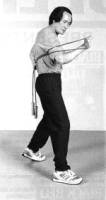

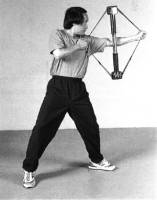

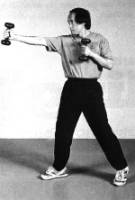


Did Bruce Lee take his training seriously?
"While Bruce was in Hong Kong filming in late 1971 or early 1972, he had his weight equipment and training gear shipped to him," says Ted Wong, who met Lee in 1967 and trained with him for more than six years. "He wanted to stay in shape. So we packed his bags, but we did not send any clothes because he said he could buy them cheap in Hong Kong. We just packed training equipment. When he saw all the bags filled with training equipment, he laughed and said, ‘Now I’m going to be able to do lots of training.’"
And train he did.
"Bruce considered training number one," says Wong. "He was constantly training. When he watched TV or went to the movies, he conditioned his knuckles. When he was driving, he worked the hand grips. If he walked to a bookstore and came to a hill, he always ran. He never wasted time."
Why was this man so obsessed with training? Several reasons:
First, according to Lee, training was important because you couldn’t perform up to your capabilities if you weren’t in shape, Wong recalls.
"Lee felt you had no business being in the martial arts if you weren’t in shape," says Wong. "If you weren’t in shape you couldn’t be 100 percent efficient."
Second, he had lofty goals.
"He wanted to be the best," says Wong. "He wanted to be the best martial artist."
And no one could dispute that he was.
Lee’s Thoughts on Strength
To get in excellent shape, Lee felt you needed strength, Wong notes.
"He considered strength training very important," Wong says. "He was constantly looking for ways to improve, including weight training and isometrics."
Although Lee felt strength was important, he did not believe bodybuilding was the answer, Wong says.
"He felt it was important to have definition, but he did not feel you had to overboard," Wong says. "He did not feel it was necessary to develop large muscles. On the other hand, strength and definition enhanced certain functions, such as kicking and punching."
And Lee’s conditioning entailed more than hand grips, sit-ups, weights, running and conditioning drills.
"A lot of the time he read books and analyzed different arts," Wong says. "He had a keen eye and an analytical mind. He did a lot of researching."
While you may never develop Lee’s skills, you can certainly train the way the "Little Dragon" did. Following are a few of the exercises Lee used to develop power.
Lee’s Strength Routine
Barbell Push
This exercise strengthens your arms, forearms, shoulders, biceps, lats, triceps, chest and abs.
"This exercise works almost your whole body," Wong says. "It’s really good; it’s effective. But it is also very difficult. Although Bruce lifted a lot of weight, most people can’t. I remember trying to lift what he used, and I couldn’t even hold it."
To begin, stand with your feet slightly wider than shoulder width. Squat, grab the barbell with an underhand grip and stand up. Keeping your elbows by your side, raise the weight straight out, hold for a second, return and repeat.
Do three sets of 8 to 12 repetitions. When you’re done, do three sets of 8 to 12 reps with an overhand grip.
Punching With a Dumbbell
This exercise improves your shoulder endurance, which is vital for sparring.
"Bruce did this drill a lot." Wong says.
Hold a five-pound dumbbell in each hand, assume a fighting stance and alternate throwing punches with each hand.
"Do these moderately fast," Wong says.
To prevent an injury, however, don’t throw your punches too fast. Do two to three sets, 10 to 15 reps per set.
"This is isometric training for power punching," Wong says. "It was one of Lee’s favorite drills because it built speed and punching power at different ranges."
To do this, you can use a jump rope, a karate belt or a strand of rope.
To begin, assume a fighting stance and hold the rope in both hands. Place your left hand behind your back, wrap the other end around your shoulder and throw a short-range punch. Hold it for five seconds, extend your punch to ¾ distance, hold it for five seconds, extend it to full range and hold.
For each arm, do five sets of five reps.
One-Hand Dumbbell Drill
This drill strengthens your wrist, which means your punches will be stronger. Lee used this exercise to enhance his one-inch punch, Wong notes.
"When your wrist is strong, you get more power," he says. "And it’s good when you’re in close range because there isn’t much room for your wrist to travel. This is a good drill for the one-inch punch."
To begin, stand with your feet about shoulder-width apart, and hold a five-pound dumbbell in your right hand. Keeping your arm to your side and using only your wrist, raise the dumbbell as high as you can and lower it as far as you can.
Do two sets of 25 reps. When you’re done, do two sets of 25 reps, moving your wrist from side to side as far as you can.
Board Isometrics
This drill is for leg strength and mobility."This exercise really puts pressure on your knees," he says. "It’s intense."
To do this drill, you’ll need a four-foot long board with a shoulder harness strapped in the middle. To begin, assume a fighting stance on the board and place the harness around your neck. Exerting a constant upward pressure, lean forward and then lean back.
"This drill enables you to develop explosive power and to close the gap [more efficiently]," He says.
Do three sets of one minute. As you improve, increase your time.
Hand Isometric Drills
This drill strengthens your forearms, which is great for trapping and punching.
You will need the board for this exercise also. Stand with your feet shoulder-width apart, wrap the straps around your forearms and exert pressure upward.
Do three sets of one minute. Don’t rest more than one minute between sets.
Bull Worker for Trapping
Again, you will also need the Bull Worker for this drill, which strengthens your forearms for trapping, grabbing and hitting.
Assume a fighting stance, place one end of the Bull Worker against your abs, and hold the other end at about head-height. As quickly as possible, pull the top part toward your abs, return and repeat.
What Made Bruce Great?
So what made Bruce Lee as great as he was?
Strength training? Genetics? Intensity?
"I think there are a lot of factors, but I think it was his drive," Wong says. "For example, he always told me you had to put 100 % effort into everything you did. He said, ‘When you throw a punch, put everything into it. Don’t just go through the motions.’ To this day I remember that, and it’s very important to me."
Bull Worker for Punching
This drill also strengthens your punching power.
To do this drill, you’ll need a Bull Worker, which you may be able to find at a sporting goods store.
Assume a fighting stance, hold the bow straps in each hand, and throw as many punches as you can, as fast as you can.
"Do these real fast, and do as many as you can," Wong says.
Do two to three sets. You can throw backfists or straight punches. This device also enables you to adjust the tension.

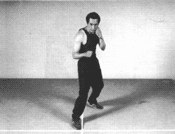
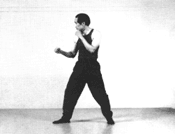
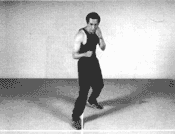


 留言列表
留言列表